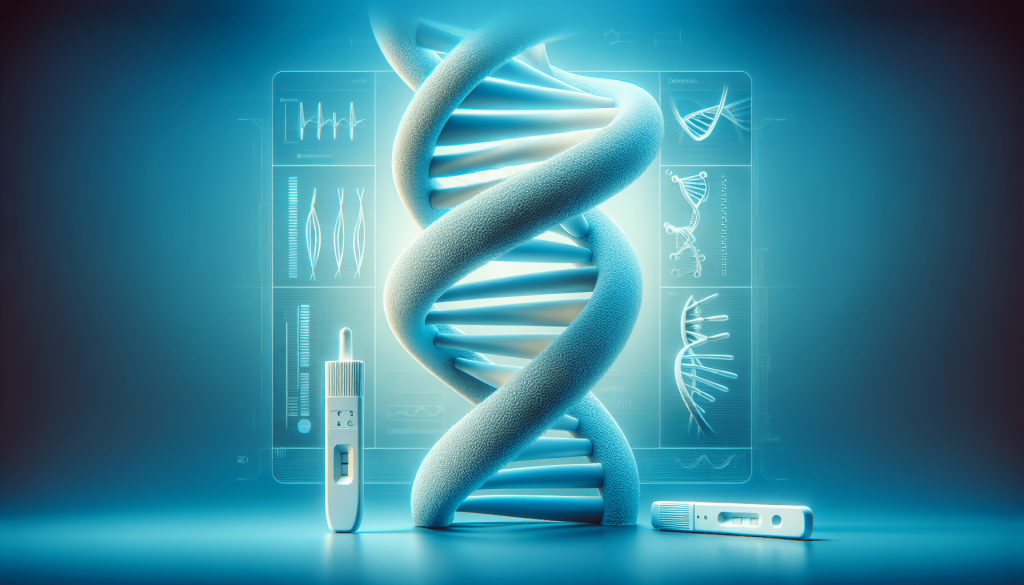Have you ever paused and wondered, “Is it safe to do a DNA paternity test at home?” In today’s world, advancements in technology have made it easier than ever to get answers to questions that once required a visit to a medical professional or laboratory. DNA paternity tests fall into this category, presenting a convenient option to many choosing to test the biological relationship between a father and child. However, before you send off for that at-home kit, it’s essential to consider various factors to ensure the process is secure and accurate.

What is a DNA Paternity Test?
A DNA paternity test involves comparing the DNA of a potential father and child to determine whether there is a biological relationship. These tests look at specific locations on the DNA where variations can determine paternity with a high degree of accuracy. The advent of at-home DNA kits offers the public an accessible means to perform these tests without the need for a medical appointment.
How Does a DNA Paternity Test Work?
A DNA paternity test usually involves collecting samples from the inside of the cheek of both the child and the potential father using buccal swabs. The collected samples are then sent to a laboratory where technicians analyze the DNA sequences. Most paternity tests examine 15 to 20 genetic markers to ensure an accuracy rate of over 99.9%.
Types of DNA Paternity Tests
There are several types of DNA paternity tests, each serving different needs and scenarios. Here is a quick summary:
| Test Type | Description |
|---|---|
| At-Home Test | Involves the collection of samples at home, with results sent back via mail. |
| Legal Test | Requires chain of custody procedures, making it admissible in court. |
| Prenatal Test | Conducted during pregnancy using either a CVS, amniocentesis, or non-invasive methods. |
| Post-Mortem Test | Used when the alleged father is deceased, requiring tissue or DNA conservation samples. |
Understanding the nuances of each test type can help you choose the one that best suits your needs and circumstances.
Pros and Cons of At-Home DNA Paternity Tests
While at-home DNA paternity tests offer numerous advantages, they also come with their own set of challenges. Delving into these can help you make an informed decision.
Pros
- Convenience: At-home tests allow you to collect samples without having to visit a medical facility. This can save time and hassle.
- Privacy: You can conduct the test in the comfort of your own home, providing a layer of privacy and discretion.
- Cost-Effective: At-home kits are often more affordable compared to tests done in medical settings.
- Ease of Use: Instructions are generally straightforward, making it easy for anyone to understand and execute.
Cons
- Accuracy Concerns: Although most at-home tests claim high accuracy, there is still room for user error during the sample collection process.
- No Legal Standing: Results from at-home tests may not be admissible in court since they don’t follow chain-of-custody procedures.
- Delayed Support: If you encounter any issues, support may be limited to phone or email, slowing down resolution times.
- Risk of Contamination: Improper handling of samples can lead to contamination, affecting the accuracy of the results.
Factors to Consider Before Taking an At-Home DNA Paternity Test
Before committing to an at-home DNA paternity test, you should walk through several important considerations. These can help you avoid pitfalls and ensure you get the most reliable results possible.
Understand the Purpose
Determine why you need the test. If it is for personal knowledge, an at-home test will likely suffice. However, if you require the results for legal purposes such as custody battles or child support claims, it’s advisable to go for a legal test that adheres to chain-of-custody protocols.
Evaluate the Testing Company
Investigate the company offering the test. Look at customer reviews, check for accreditation from organizations such as the American Association of Blood Banks (AABB), and see if the tests are performed in certified laboratories.
Informed Consent
Ensure you have the consent of all parties involved, especially when testing minors. Unauthorized sample collection can lead to legal consequences and ethical dilemmas.
Follow Instructions Meticulously
Closely follow the instructions provided in the kit to avoid inaccuracies. Improper sample collection is a common pitfall that can lead to incorrect results.
Verify Sample Handling
Make sure you understand the proper way to handle, store, and mail the collected samples to prevent contamination. Seal and label everything as instructed.
Assess Costs
Look beyond the initial cost of the kit. Some companies may charge additional fees for lab work, shipping, or expedited results. Understanding the full cost upfront can save you from unexpected expenses.
Safety Concerns with At-Home DNA Paternity Tests
The appeal of at-home DNA paternity tests is undeniable, but several safety concerns must be addressed to ensure a secure experience.
Data Privacy
Your genetic information is highly sensitive. Ensure the testing company has strict data privacy policies in place to protect your information. Review their privacy policy to see how your data will be used and stored.
Sample Contamination
Contamination is a genuine risk when collecting samples at home. To minimize this, follow the provided instructions carefully. Wash your hands before sample collection and avoid touching the swab tips.
Accuracy and Quality Control
Check if the testing lab adheres to standardized quality control measures. Accredited laboratories typically undergo regular audits to ensure accuracy and reliability.
Psychological Impact
The results of a paternity test can have profound emotional and psychological impacts on all parties involved. Consider seeking counseling or talking with a professional to prepare for possible outcomes.

How to Interpret DNA Paternity Test Results
Interpreting the results of a DNA paternity test can be straightforward, but it’s crucial to understand what the terms mean.
Probability of Paternity
Most results will express the probability of paternity as a percentage. A 99.9% probability or higher usually indicates that the tested man is the biological father. Conversely, a probability of 0% means he is not.
Combined Paternity Index (CPI)
The CPI is a ratio that shows how many times more likely it is that the tested man is the biological father compared to a random man from the same ethnic group. A higher CPI indicates greater likelihood of paternity.
| Term | Meaning |
|---|---|
| Probability of Paternity | Expressed as a percentage, it indicates the likelihood of the biological relationship. |
| CPI | The ratio showing how much more likely the tested man is the father compared to any random man. |
Legal Implications of DNA Paternity Test Results
The legal stakes of paternity can be high, potentially affecting child support, custody, and inheritance. It’s essential to understand how these results can be used legally.
Non-Admissibility of At-Home Tests
At-home paternity test results generally do not hold up in court because they do not follow a strict chain-of-custody protocol. If the outcome has legal implications, opt for a legal test administered by certified professionals.
Chain of Custody
A “chain of custody” involves securely managing and documenting the sample’s collection, transfer, storage, and analysis to ensure it has not been tampered with. Only tests following this procedure are typically admissible in court.
Impact on Child Support and Custody
Establishing paternity can affect child support and custody arrangements significantly. Validating paternity through a legally recognized test can clarify roles and responsibilities, benefiting both the child and the parents.
Consent and Legal Authorization
Taking a paternity test without the consent of the other parties involved can lead to legal issues, including potential charges of fraud or invasion of privacy. Always get the required permission before proceeding.
Ethical Considerations
The decision to undertake a DNA paternity test should not be made lightly. It involves several ethical considerations.
Rights of the Child
Children have rights to know their biological parents but also to be protected from potentially distressing information. Weigh the child’s best interests before deciding to perform a paternity test.
Emotional Well-being
The results of a DNA paternity test can affect relationships, impacting the emotional well-being of the parent(s) and the child. Consider discussing the decision with a family counselor or psychologist.
Confidentiality
Maintain confidentiality throughout the process. Sharing sensitive results irresponsibly can harm relationships and reputations.
FAQs: DNA Paternity Tests at Home
1. How accurate are at-home DNA paternity tests?
At-home DNA paternity tests are typically highly accurate when the instructions are followed carefully. Laboratories often claim an accuracy rate exceeding 99.9% for properly collected samples.
2. How long does it take to get the results?
The turnaround time can vary, but most companies provide results within 3 to 5 business days after receiving the samples. Expedited services may be available for an additional fee.
3. Can I use an at-home test for legal purposes?
No, at-home test results are generally not admissible in court because they lack a chain-of-custody protocol. For legal purposes, you will need to undergo a test that adheres to these procedures.
4. What if the samples get contaminated?
If contamination is a concern, contact the testing company for a replacement kit. Contaminated samples can lead to inaccurate results, so it’s crucial to handle the process with care.
5. What steps are involved in collecting a sample at home?
Typically, you will use a buccal swab to collect cells from the inside of your cheek. Ensure your hands are clean, avoid touching the tip of the swab, and follow all provided instructions carefully.
Conclusion
The convenience and privacy of at-home DNA paternity tests make them an attractive option for many. However, it’s crucial to balance these benefits against potential downsides, such as accuracy concerns and limited legal standing. By thoroughly considering the factors discussed here—understanding the type of test you need, assessing the quality of the testing company, following instructions meticulously, and contemplating ethical and emotional implications—you can ensure a safe and reliable paternity testing experience. Your peace of mind and the well-being of all involved parties are paramount, making thoughtful preparation essential.
